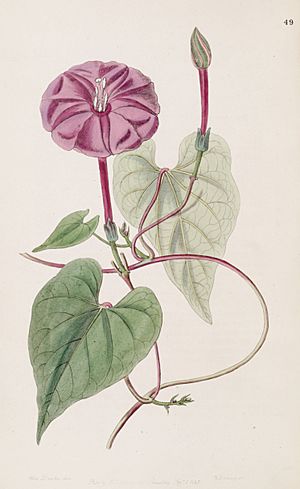Ipomoea purga facts for kids
Quick facts for kids Ipomoea purga |
|
|---|---|
 |
|
| Scientific classification | |
| Genus: |
Ipomoea
|
| Species: |
purga
|
Ipomoea purga is a type of flowering plant. It's a vine that belongs to the Ipomoea family. People often call it jalap. Some also believe it's the plant known as the John the Conqueror root.
About the Plant
Ipomoea purga is a climbing plant, like a vine, that can grow up to about 12 feet (3.6 meters) tall. Its root is black on the outside and white and milky on the inside when it's fresh. The size of the root changes as the plant gets older.
This plant has leaves shaped like hearts. Its flowers are purple and look like trumpets. Ipomoea purga is originally from Mexico. It has also started growing naturally in other warm parts of the Americas.
A Look Back in Time
Spanish explorers, called conquistadores, found Ipomoea purga when they came to Mexico a long time ago. In 1565, the plant was brought to Europe. For many years, people used it as a special herb for medicine to help with different sicknesses. This continued until the 1800s, when new and modern medical ways became more common.
Traditional Uses
The root of Ipomoea purga has a substance called convolvulin. This substance was traditionally used as a strong cathartic. A cathartic is something that helps the body clean itself out, often by making you go to the bathroom.
Historically, it was used to help with stomach problems. However, using too much of it could make someone throw up.
See also


